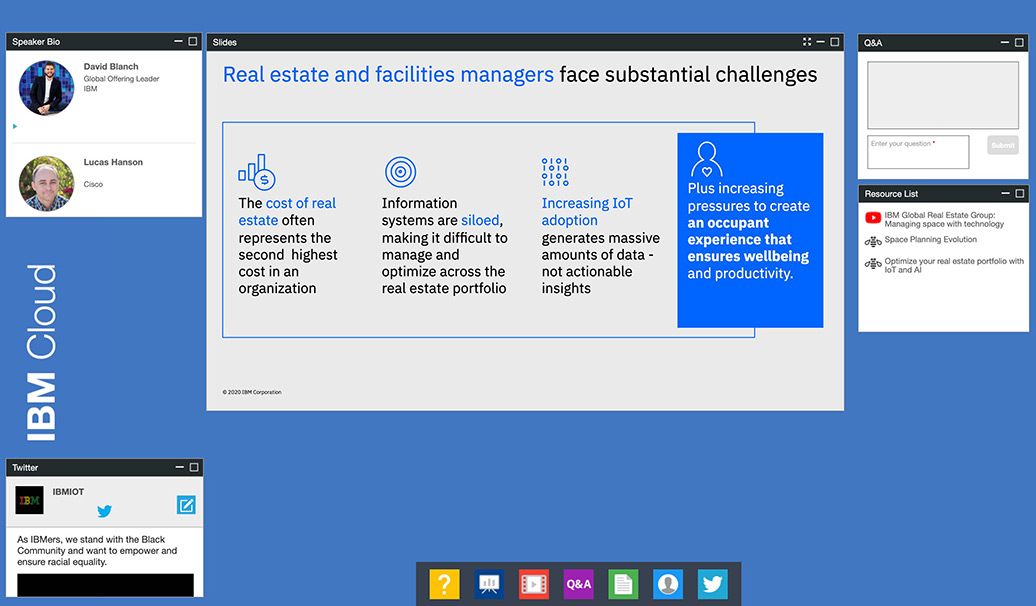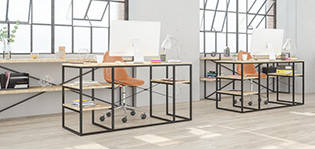Work safe. Work smart. Return with confidence: a pragmatic guide
01
1 min read
Reimagine your workplace
Practical steps to protect people and spaces
Where and how we work has never seemed so complicated.
As we plan for the return back - to public structures, corporations, and campuses – how we manage our buildings and our spaces, and how occupants engage with that space to do their work, is critical.
Whether you’ve remained open as an essential service or are considering how to bring people back, it’s imperative that you prepare a space in which workers feel protected.
To do that, you need to:
- Monitor and manage occupancy to optimize space utilization.
- Organize spaces and provide workplace services to ensure occupant safety.
- Ensure readiness across your facilities by adhering to new protocols and processes.
As you develop the nuts and bolts of your strategy, there are some practical tasks that will help you prepare your facilities to meet the new demands:
Monitor occupancy to support new capacity policies
Create temporary space plans for social distancing
Enable more reservable spaces to book in advance
Deliver workplace services for employees
Manage new facilities cleaning and maintenance projects
Monitor inventory by location for critical supplies
02
1 min read
Get started
Focus on business continuity and occupant well-being
As organizations grapple with reopening facilities, some things are obviously out, like the tightly packed seating arrangements, cozy collaboration spaces and crowded elevators.
Instead, your return to the workplace strategy has to ensure occupant safety and compliance. These are critical to help you mitigate risk as you begin to reopen your facilities.

Discover pragmatic advice on how to build your own return to work strategy:
- Ensure the readiness of your facilities operations and maintenance
- Develop robust business continuity plans to address any situation
- See a demonstration of technology in action that can help you build your strategy today
It’s information you can use now!
03
2 min read
Get practical advice
Discover new ways to create a safer workplace
It’s hard to prepare for global disruption. But it’s good to know that other real estate and facilities management professionals have found ways to reimagine and create a safer, more efficient workplace, even in the face of huge challenges:
It doesn’t matter if
they’re facing hurricanes, earthquakes, floods or pandemics, the United
States Air Force has to keep its 110,000 assets including 43,000 buildings,
operating at peak efficiency. Hear why TRIRIGA is mission-critical to their
efforts.
“We can do business smarter, faster and better, and ultimately
cheaper for the taxpayer.”
Rob Morgan
NexGen IT
Program Manager
U.S. Air Force
When 95% of employees
suddenly shifted from the office to working from home, the IBM Global Real
Estate team was ready with critical space utilization data that made
handling this unprecedented move easier.
“We truly would have a really hard time navigating through this
without TRIRIGA.”
Marianne Flores
Director Global Real
Estate Operations
IBM Global Real Estate
EY, one of the world’s
largest professional services firms, has positioned themselves to
effectively manage change and deliver on the high expectations of today's
workforce. How? By expecting the unexpected and using the right technology.
“You do have to expect the unexpected when you're working in
corporate America.”
Sandra Corkern
Workplace Management
Leader
Ernst & Young
Listen to how these iconic names are addressing some of the biggest challenges they’ve ever faced by attending TRIRIGA Academy, a free and on demand online learning event.
04
1 min read
Dig into occupancy
Measure the metric that matters the most
As you build your return to the workplace strategy, one of the most important metrics you need is occupancy utilization.
Whether your workforce has shifted from corporate cubes to home-based, or you offer essential services that require fully operational buildings, you need to know who is using your space, at any time, all the time.
Key questions to ask:
- Who is occupying my facilities and when?
- Are there opportunities to consolidate space?
- Should we reconfigure or repurpose existing space?
If you’re making critical space decisions with manually intensive work and less-than-perfect data, now you can harness your information, make informed decisions based on real-time occupancy insights, and react quickly to changing business demands.

IBM TRIRIGA and Cisco have teamed up to give you the tools you need to deploy location sensing using your existing WiFi network infrastructure. Scale quickly and get faster, more accurate occupancy insights. It’s the fastest way to reimagine and streamline your spaces.
Listen to the IBM/Cisco webinar.05
2 min read
Jump-start your projects
Get your facilities ready to reopen
Preparing your facilities to be their safest means rigorous and constant adherence to new standards. That can lead to new projects.
You may need to:
- Install high-efficiency air filters, hand sanitizing stations, no-touch trash cans, barriers between desks or workstations
- Provide access to Personal Protective Equipment
- Increase air ventilation rates in the work environment
- Install new signage
- Reconfigure spaces for social distancing protocols

You may also need to enhance your maintenance and operations routine tasks including:
- New maintenance, cleaning and disinfecting protocols
All of these — while necessary — take resources at a time when your company might be facing economic challenges.
A capital planning tool can help. The most effective capital planning starts with a comprehensive view of your current infrastructure. Then, you can include any new efforts you need to take, track those along with your other ongoing costs of repairs and scheduled maintenance. You’ll have a holistic picture that lets you predict maintenance, refurbishment, or replacement timelines and cost.




